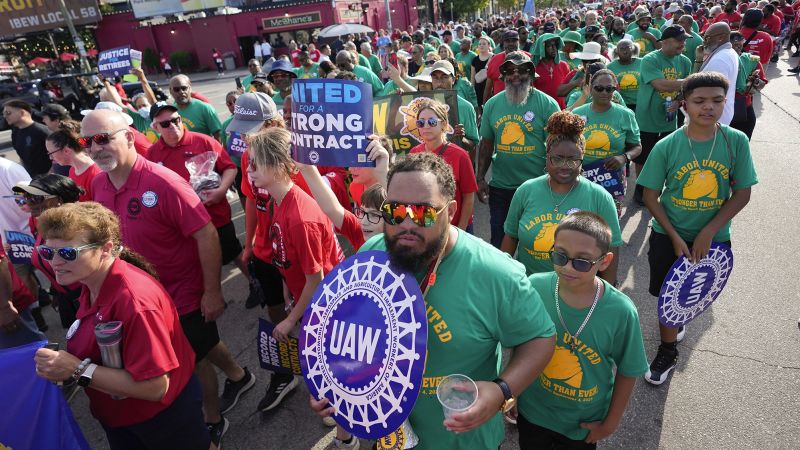Time is running out to avert a strike that could shut down America’s unionized auto assembly plants and other manufacturing facilities.
The United Auto Workers contracts expire at 11:59pm Thursday. The contracts cover 145,000 UAW members at the three companies: General Motors, Ford and Stellantis, which builds vehicles under the Jeep, Ram, Dodge and Chrysler brands for North America.
If there’s no new deal by the contract expiration, the union has said it will start targeted strikes against a undisclosed number of facilities at each company.
Here’s what to watch as the clock ticks down:
It might not take much to virtually shut down the output from all the companies.
The companies operate a complex network of plants that depend on getting parts from different facilities.
Slowing or stopping the production of a few engine or transmission plants at each company could be as effective at stopping operations as a full strike at all plants, according to industry experts.
One engine or transmission location per company might be enough to shut down nearly three-quarters of the US assembly plants, said Jeff Schuster, global head of automotive for GlobalData, an industry consultant.
“Two plants per company, you can pretty much idle North America,” he said.
Halting the companies’ assembly lines would likely happen in less than a week that way, Schuster said.
One advantage of a targeted strike for the union is the potential to save resources and extend a possible walkout. Striking union members are eligible for $500 a week from the union’s strike fund.
If all 145,000 UAW members among the three automakers were to strike at the same time, it could cost the fund more than $70 million a week, draining the $825 million fund.
With targeted strikes, it’s possible that the companies will shut down operations and lay off members who are not technically on strike. That could make them eligible to receive state unemployment benefits rather than strike benefits, which could preserve the union’s resources.
Strikers are not eligible for unemployment benefits, but workers who are on temporary layoff can receive the benefits, which differ by state but would be less than the union’s $500 strike pay. There also are legal questions in different states about qualifying for unemployment.
An official with Ford told reporters Thursday that under state law, workers in Michigan and Ohio were not eligible to receive unemployment benefits if they were laid off due to lack of parts at their plant caused by a strike. There are some other states, such as Kentucky and Tennessee, where they would be able to receive unemployment benefits, according to the officials.
But they said none of the Ford UAW members would be eligible for so-called “sub-pay,” which they typically receive during temporary layoffs. Sub pay is far more lucrative, covering most of the gap between unemployment benefits, typically less than $300 a week, and normal company pay, which can be close to $1,300 a week.
A union spokesman said earlier Thursday that he couldn’t comment on members’ eligibility for unemployment benefits if they were laid off due to plants shutting down from lack of parts caused by the strike.
UAW President Shawn Fain told his members in a Facebook Live appearance Wednesday evening that if they are not in one of the plants that the union picks to go on strike, they should stay on the job. He said in that case they would be working under an expired contract, rather than on an extended contract.
Fain said he would announce at 10 pm Thursday which plants have been selected to go on strike. Among the likely targets, Schuster said, are a Stellantis transmission plant in Kokomo, Indiana, a GM transmission plant in Toledo, Ohio, and a Ford transmission plant in Livonia, Michigan. Those three plants have just over 6,000 UAW members on staff, according to figures available from the companies’ websites.
Fain also said in his remarks Wednesday night the union would not hold talks Friday if there is a strike.
But there is still a chance no plants will go on strike and no operations will be disrupted. While Fain warned members that a strike appeared likely – “We’re likely going to have to take action,” he said during his remarks Wednesday – he also said there had been movement at the bargaining tables.
Fain said that all the automakers had boosted the amount they were offering to raise wages, with Ford now offering a 20% raise during the life of the contract, GM is offering 18% and Stellantis is offering 17.5%, although Fain cautioned that still did not meet the union members’ needs, which had started with a demand for an immediate 20%, and four additional raises of 5% each over the course of a four-year deal.
And all the automakers issued statements saying they want to reach tentative labor deals before the deadline that would avoid a strike. Despite the difference, there is a chance for an 11th hour settlement or settlements.
Negotiators for each of the automakers and the UAW have been at the bargaining table at the UAW headquarters in Detroit, also known as “Solidarity House,” since Wednesday morning, according to a source with knowledge.
GM CEO Mary Barra sent a letter to employees Thursday saying the company’s latest offer now include a 20% raise, with an immediate 10% pay hike. The lower paid temporary employees would get $20 an hour, which represents at 20% raise from current $16.67 an hour they receive. She called the offer “historic.”
“We are working with urgency and have proposed yet another increasingly strong offer with the goal of reaching an agreement tonight. Remember: we had a strike in 2019 and nobody won,” she said in the letter.
Ford CEO Jim Farley told CNN the offer from Ford of a 20% raise over the life of the contract is the most lucrative offer the company has made to the union in the 80 years it has been there. But he said meeting the union’s demands of close to a 40% raise, along with a four-day work week and other benefit improvements, would have been unaffordable.
“If we had done that with our business, and we’ve had a couple of really great years here we would have gone bankrupt many years ago. We would have had to close plants. Most people would have lost their jobs. We couldn’t run our business today,” Farley said.
Farley blamed the union for the lack of progress in negotiations. But union has blamed the companies for waiting until the end of August or early September to make their first counteroffers.
The union came up with the 40% raise request based on the increase in the pay of CEOs at the three automakers over the last four years. Ford CEO pay rose 21%, from $17 million for Farley’s predecessor Jim Hackett in 2019, to $21 million for Farley last year. (Farley is the lowest compensated of the three CEOs.)
Asked why the union workers shouldn’t get the same huge increases, Farley responded, “We’re really open to huge increases.” As to the 40% increases for CEOs, Farley responded, “I wasn’t CEO four years ago, but we have put on the table huge increases, double digit increases.”
Ford has not had a strike since 1978; it has more UAW workers than the other two automakers.
“We don’t want there to be a strike. We’re ready to work until the deadline,” he said. “We’d like to make history by making a historic deal, not having a historic strike,” he said.
President Joe Biden spoke with Fain and leaders of the major auto companies “to discuss the status of ongoing negotiations,” the White House said Thursday.
The White House declined to say Wednesday that Biden would support UAW workers if they chose to strike.
“I’m gonna leave it at, [Biden] believes the auto workers deserve a contract that sustains middle class jobs and wants the parties to stay at the table, to work round the clock to get a win-win agreement,” Council of Economic Advisors Chair Jared Bernstein told reporters during Wednesday’s White House press briefing.
Biden became directly involved in 11th hour negotiations a year ago to stop engineers and conductors at the nation’s major freight railroad from going on strike and was credited by both sides with a deal being reached at that time. But Biden and Congress had power under a different labor law to keep workers on the job by imposing a contract, a power he used later in the year when rank-and-file rail workers rejected the deal he brokered and again threatened to strike
But the autoworkers fall under a different labor law, one that leaves Biden with no power to stop a walkout. And he has limited influence with the UAW, which has been critical of his push to have the industry convert to electric vehicles, a move that could cost members jobs in the long run.
There are separate union contracts at each of the traditional Big Three. That means there could be a tentative labor deal reached at Ford and GM that keeps those workers on the job, while the employees at Stellantis could go out on strike.
Ford has not had a national strike since 1976 and has not had a strike of any kind at its US plants since 1978.
In contrast, experts say Stellantis, which builds vehicles under the Jeep, Ram, Dodge and Chrysler brands, could see workers walk off.
“I think there’s a 99% chance of a strike at Stellantis,” said Art Wheaton, director of labor studies at Cornell University’s Industrial and Labor Relations school in Buffalo.
Stellantis is making greater use of lower-paid temporary workers than the other automakers. Eliminating or at least limiting use of temporary workers is a major issue for the union.
And Wheaton said there is still more anger at Stellantis than at other automakers after former executives of the company were caught giving bribes to former union officials. Many of the members who are angry at the corruption scandal that resulted in two recent UAW presidents going to prison are angry with Stellantis as well. A promise to prevent corruption within the union was one of the major issues in the campaign that Fain waged to become the first popularly elected union president five months ago.
Fain also formerly worked for Chrysler, the Stellantis predecessor, and was involved in contentious labor negotiations with the company even before he was elected president.
If the two sides are close to a deal at the deadline, they could agree to a temporary contract extension for hours or even days. That extension could even go on for months, as with the West Coast ports during negotiations with the International Longshore and Warehouse Union last year and earlier this year.
Fain has repeatedly said that the 11:59 pm contract expiration is a “deadline, not a reference point.” In past negotiations, the union has sometimes chosen only one automaker to strike, while staying on the job at the other two. Once a deal was reached, the union moved to get the other automakers to accept that “pattern” as the basis for their own contract.
But Fain insists the union will not follow that playbook this time.
Sometimes one or both sides will walk away before the final minute before a contract expiration. Although the strike might not start until after the deadline, a breakdown of talks could kill the chance for an 11th-hour deal.
That’s what happened in bargaining in May between the Writers Guild of America, which represents 11,000 writers, and the Alliance of Motion Picture and Television Producers, which represents major studios and streaming services in the contract negotiations. While the contract was due to end at midnight PDT, the talks ended about three hours earlier.
Sometimes after talks break down, the parties can return to the table and reach a deal without a strike. That happened in July at UPS, as talks between the company and the Teamsters union ended after a marathon negotiating session in the early hours of July 5. Official talks did not resume for nearly three weeks. But when the two sides met again on July 25, they quickly reached a deal that averted an August 1 strike.
But a break in talks at any of the automakers at this late date would not be a good sign.
– CNN’s DJ Judd contributed to this report
Read the full article here













Leave a Reply